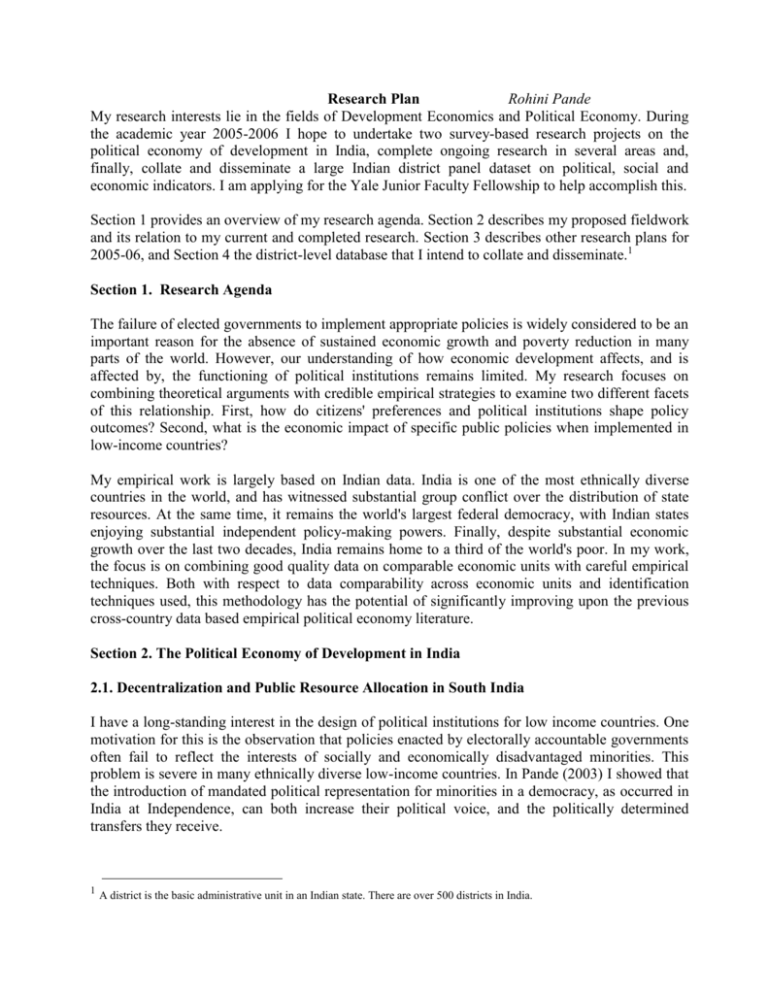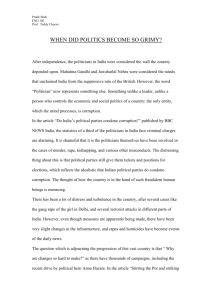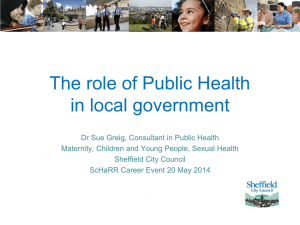JFF
advertisement

Research Plan Rohini Pande My research interests lie in the fields of Development Economics and Political Economy. During the academic year 2005-2006 I hope to undertake two survey-based research projects on the political economy of development in India, complete ongoing research in several areas and, finally, collate and disseminate a large Indian district panel dataset on political, social and economic indicators. I am applying for the Yale Junior Faculty Fellowship to help accomplish this. Section 1 provides an overview of my research agenda. Section 2 describes my proposed fieldwork and its relation to my current and completed research. Section 3 describes other research plans for 2005-06, and Section 4 the district-level database that I intend to collate and disseminate.1 Section 1. Research Agenda The failure of elected governments to implement appropriate policies is widely considered to be an important reason for the absence of sustained economic growth and poverty reduction in many parts of the world. However, our understanding of how economic development affects, and is affected by, the functioning of political institutions remains limited. My research focuses on combining theoretical arguments with credible empirical strategies to examine two different facets of this relationship. First, how do citizens' preferences and political institutions shape policy outcomes? Second, what is the economic impact of specific public policies when implemented in low-income countries? My empirical work is largely based on Indian data. India is one of the most ethnically diverse countries in the world, and has witnessed substantial group conflict over the distribution of state resources. At the same time, it remains the world's largest federal democracy, with Indian states enjoying substantial independent policy-making powers. Finally, despite substantial economic growth over the last two decades, India remains home to a third of the world's poor. In my work, the focus is on combining good quality data on comparable economic units with careful empirical techniques. Both with respect to data comparability across economic units and identification techniques used, this methodology has the potential of significantly improving upon the previous cross-country data based empirical political economy literature. Section 2. The Political Economy of Development in India 2.1. Decentralization and Public Resource Allocation in South India I have a long-standing interest in the design of political institutions for low income countries. One motivation for this is the observation that policies enacted by electorally accountable governments often fail to reflect the interests of socially and economically disadvantaged minorities. This problem is severe in many ethnically diverse low-income countries. In Pande (2003) I showed that the introduction of mandated political representation for minorities in a democracy, as occurred in India at Independence, can both increase their political voice, and the politically determined transfers they receive. 1 A district is the basic administrative unit in an Indian state. There are over 500 districts in India. My ongoing research on how the choice of political institutions can influence the public resource allocation process is based on a large household and village survey of public good provision that I undertook with T.Besley and V.Rao in 2002. The survey covered 522 villages and over 5500 households (including 550 politician households) in the four South Indian states. These villages have had elected local governments since 1993. The survey included an audit of village facilities, village meeting data on local government activism and citizens’ public good concerns, and household survey data for a random sub-sample of 260 villages. In a series of papers (Besley, Pande, Rao and Rahman (2004) and Besley, Pande and Rao (2004a), (2004b)) we use this data to identify how access to political authority, and the use of political power, affects public resource allocation. We also examine how the choice of political institutions affects politicians’ policy decisions. Our results favor a model in which public resource allocation, both across and within villages, reflects politicians' self-interest. However, we also find evidence that the extent and type of political opportunism in resource allocation is responsive to the design of political institutions. Given the relative paucity of household political surveys, this data has the potential of greatly improving our understanding of the politics of public resource allocation in village India. However, it is clear that by resurveying these villages and collating a panel dataset we could undertake a richer analysis of the dynamics of political participation and examine how over-time changes in politician and household characteristics affects public resource allocation. We could also examine how changes in public resource allocation have affected growth in these villages. We are, therefore, planning a resurvey of these villages and households in 2006 and have applied to the World Bank for funding. During the summer/fall of 2005, in collaboration with an Indian survey company, we will run pilot surveys in our sample villages to identify how public resource allocation in these villages has altered over the last four years. In addition, we will carry out focus group meetings to discuss our research findings with villagers, and thereby improve our interpretation of the research findings. The results of both the pilot surveys and focus groups will inform the design of the questionnaires for the next survey round. Conditional on getting funding, we anticipate starting the main survey in March 2006. Together with Esther Duflo (MIT) I am also undertaking a qualitative data based research project on the conduct of village meetings in a subsample of our survey villages, and their implications for public service delivery. Village governments are required to hold annual village meetings open to all villagers. These meetings are intended as a forum for villagers to monitor the public resource allocation process, and also to improve information flows between politicians and citizens. We have recorded meetings in 200 of our survey villages, and are currently having these recordings transcribed and coded. We expect the coding to be completed in another six months. During 200506 we intend to complete our analysis of how village characteristics affect the dynamics of these meetings, and how the conduct of these meetings, in turn, affects public resource allocation. 2.2. Service Delivery and Corruption Casual observation suggests wide variation, both within- and across- countries, in the degree of corruptibility and competence among politicians. It is also widely believed that political corruption has large economic costs, and, in particular, that these costs may be disproportionately borne by the poor and other vulnerable sections of society. Yet our knowledge of what causes politician corruption remains limited. Together with Abhijit Banerjee (MIT), I have initiated research on these issues in the context of India's most populous state -- Uttar Pradesh (now on, UP). India is a country that has long grappled with the problem of corruption in public life, both through economic and political reform. Political corruption in UP, in particular, has received much media attention -- over 25 percent of the candidates in the 2002 state election had a criminal record (The Economist, 13 May 2003) Our research will document the evolution of politician corruption over the last four decades in UP, and examine how economic development and political competition has affected politician corruption. In the summer of 2004, with NSF funding, we conducted a survey in UP, which tracked the political and economic record of the winner and runner-up in two randomly selected constituencies in every UP district for the election years of 1969, 1980 and 1996. We are now cleaning these data and putting together a data-set on the extent of political competition in these constituencies, and public resource allocation in these districts for the same time period. We will use these data to examine whether a district's potential for economic development, the extent of political competition, or both, influence the extent of politician corruption. To address the concern that political corruption and, say, economic development in a district may be jointly determined by unobserved variables, such as changing social norms vis-à-vis wealth accumulation by politicians, we will exploit `shocks' to the economic and political environment of UP districts that arguably only affect the explanatory variable(s) of interest. For instance, it is often said that the process of providing public goods brings an opportunity for political corruption. To investigate this, we will use district data on the amount spent on the construction of bridges, dams and national and state highways. Our analysis will exploit the fact that while the overall budget for any public good is determined at the state-level the district-wise allocation of this budget is, at least in part, determined by district geographic characteristics. For a given level of overall spending, we can, therefore, predict district-wise spending by district geographic characteristics. In so far as district geography has no direct effects on politician quality, by examining how geography induced variations in district public spending affect politician quality we can identify the causal impact of public spending on politician corruption. We aim to complete this research during 2005-06. During our fieldwork we obtained substantial anecdotal evidence on the connections between politicians and contractors for public works. The suggestion is that district politicians can affect which contractors get the project in their district, and that bribing politicians to get these contracts is an important element of political corruption. During 2005-06 I would like to study the contractor-politician nexus in more detail. In particular, I wish to examine whether public work projects completed by contractors belonging to politician families are of worse quality than those completed by contractors with no links to politicians. This research will provide evidence on how corruption affects economic development. I hope to undertake fieldwork for this project in the summer of 2005. The aim is to focus on the sample of politicians in office in 1996 used in our previous survey, and examine which of them have links with registered contractors in the state (the list of registered contractors is available from government public works department). I am also in touch with a private engineering company that is willing to undertake a survey of the quality of public works. Here we will survey public work projects completed by contractors related to politicians in our sample, and by a random sample of contractors who are not related to any politicians. I will use these data to examine whether there are systematic differences in the quality of projects completed by politically connected and politically unconnected contractors. Section 3. Economic Impact of Public Good Provision The second strand of research that I intend to pursue during 2005-06 examines the economic impact of public good provision in low-income environments. My previous work in this area includes the use of Indian state-level data to evaluate the poverty implications of a large state-led rural branch expansion program (Burgess and Pande (forthcoming)). This work both emphasized the relevance of extending credit opportunities to the poor, and identified regulations that caused banks to lend to the poor. 3.1. Political Economy of Public Good Provision: Dams and Development A number of recent studies document the fact that often, in representative democracies, electoral motives, rather than citizens' needs, drive the geographical allocation of public goods. However, existing evidence does not tell us whether politically motivated provision of public goods worsens economic outcomes or simply redistributes resources between the politically powerful and weak. The proposed project (joint with Esther Duflo, MIT) will use data on large dam construction in India to provide some evidence on this question. Specifically, we will examine whether reductions in poverty and inequality in an Indian district are correlated with dam construction. While the economic relevance of large dams, and the political nature of their allocation, has been the center of public debate in India and elsewhere, no rigorous evaluations of their large scale economic impact exist. Roughly half of India's 466 districts have, at least, one dam. A dam is the quintessential `pork barrel' project. That is, its benefits are geographically concentrated but its costs are paid through general revenues. It is plausible that richer or politically more connected districts obtain more resources for dam construction. For this reason we undertake a two stage analysis. First, we will predict dam construction on the basis of district geographic features. Here, we will exploit a non-linearity in the dam construction and district/river slope relationship -- moderate, but not extreme, changes in water elevation aid dam construction. We will then examine whether the so-predicted dam construction causes changes in district poverty and inequality outcomes. This method of identifying the causal impact of dams on poverty and inequality outcomes is valid as long as the district/river slope variables do not have a direct non-linear impact on poverty and inequality outcomes. Over the last six months we have put together a district panel data-set on man-made dams constructed in India up to 1997. Alongside we have used geo-spatial data to collate district geographical information. These data-sets have been matched with the Indian Agricultural data-set which provides detailed annual district agricultural output and wage data. 2 Finally, we have used Indian household survey data to construct a district poverty and inequality data-set (1973-2000). We hope to complete the preliminary analysis by summer 2005, and after receiving feedback from colleagues, to complete the analysis during fall 2005. 3.2. The Political Economy of Group Conflict Resource scarcity and conflicting redistributive preferences in the polity constitute the building blocks of most political economy models. Typically, the extent of such conflict in these models is related to economic inequality in society. However, a recent empirical literature notes the relevance of ethnic/racial diversity in explaining the incidence of conflict in low income countries. Group identity in these countries may simply proxy for economic identity (in Edlund and Pande (2003) I explored this idea in the context of gender differences in political preferences). However, it is also feasible that, independent of economic status, an individual's group identity molds his/her policy preferences. Understanding the relative importance of these two explanations has important policy implications for the design of political institutions and redistributive policies. During 2005-06, I will be working with Debraj Ray (NYU) on the impact of economic development in India on the incidence of Hindu Muslim conflict. Typically, gains from economic growth are unequally distributed across occupations, and (religious) groups differ significantly in their occupational structure. Our research will build on these observations -- we will examine whether the incidence of communal violence is more concentrated amongst high growth occupations, and, if so, whether it also varies with the extent of minority presence in that profession. While still in its preliminary stages, I have initiated work on identifying and collating the necessary data and over the next year plan to develop a theoretical model that will offer predictions which can be taken to this data. We hope to complete the analysis by summer 2006. Section 4. Indian District data-set To date, a significant constraint on empirical research in this field has been the limited availability of reliable panel data on quality of governance and poverty and inequality outcomes for low-income countries. An important research objective is the construction, use, and dissemination of an Indian district panel data-set which contains information on an array of economic and political outcomes. These indicators have been constructed by myself and fellow researchers in the course of our work, and include measures of group conflict, political outcomes, inequality and poverty indicators (constructed from the quinquennial National Sample Surveys household datafiles (now on, NSS) 1973-1999), and an array of geographical indicators. These data-sets will be matched with existing Indian district agriculture and demographic data-sets. The data-sets will typically consist of annual data for the period 1970-2000. I have received NSF funding (2004-07) to cover the research assistance costs associated with this project. Note: All papers referenced in the Statement are described in the curriculum vitae. 2 The publicly available version covers 1955-1987. We have initiated work on extending this data-set to more recent years.







